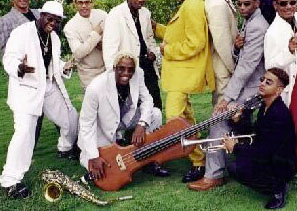Indice - Table of contents
New Stuff[hide]
Musicos: Rafael Paseiro Monzón
Musicos: Dennis Nicles Cobas
Musicos: Jiovanni Cofiño Sánchez
Musicos: Yasser Morejón Pino
Fotos: Tom Ehrlich : 2024 Monterey Jazz, P...
Resenas: Vacilón Santiaguero (Circle 9 ...
Staff: Bill Tilford
Fotos: Tom Ehrlich : 2024 Monterey Jazz, P...
Fotos: Tom Ehrlich : 2024 Monterey Jazz Fe...
Fotos: Tom Ehrlich : testing 123
Grupos: Pupy y los que S... : Discography - 1995- F...
Reportes: From The St... : Cubadisco 2...
Reportes: From The St... : Jazz Plaza ...
Fotos: Tom Ehrlich : Irakere 50th Annivers...
Photos of the Day [hide]
SpanishEnglishStudy - Conversations in Timba - About the MIDI Recordings
About The MIDI Recordings

Tirso Duarte, Randolph Chacón, Yulién Oviedo
These recordings were made in November of 2000, when I had a chance to meet with Tirso Duarte, Yulién Oviedo and Randolph Chacón of Charanga Habanera when they toured California. I had already met a number of times with Tirso in Havana, but this was one of my first attempts to make MIDI recordings of percussion as well as piano.
The keyboard is perfectly suited for the learn-by-MIDI technique since the player is playing the same type of instrument he plays on the gig. The computer just "taps into the line" between the keys and the sound-producing section of any keyboard and captures the notes and exact timing of the keystrokes. It also captures two other aspects which are critical to making any tumbao "swing" -- the point where the key is released and the force with which it's played. So if Tirso plays the keyboard live and then I play back the MIDI recording through the same keyboard, the two are indistinguishable. I started out by having the piano players simply play a single tumbao, but with Tirso, I later realized that he was fully capable of playing his piano part all the way through, listening only to a quantized clave and conga click track, with no other musicians to cue him as to where he was in the arrangement and no written music. He could also play many of the other musicians' parts!
Later, I bought a Roland SPD-20 MIDI percussion controller, which has a kick drum pedal and 8 rubber squares which can be triggered with drumsticks, or even the hands. I mapped these to sampled percussion sounds and began to try to make MIDI recordings of percussion as well. Obviously, this setup is infinitely inferior to the keyboard approach. The MIDI samples do get louder when the pad is hit harder, but their timbre doesn't change, and, much more important, the little plastic drum simulator doesn't feel anything like a real drum, bell, or cymbal. The result is that neither the sound nor the performance can hope to equal a real performance on a real instrument. Some percussionists dislike it, and others accept its limitations and do what they can with it. Yulién Oviedo is such a musical genius that he adapted to it within seconds and immediately was able to play all the percussion in these examples without the slightest difficulty. With Tirso's parts in his headphones, he laid down 3 tracks: timbales, congas and campana bell. Since the computer records MIDI and not audio, I was then able to put the kick, clave, bell, etc. on separate tracks so I could mute and solo them.
Although I had no way of recording MIDI bass, I couldn't resist the temptation to somehow capture some of Randolph Chacón's bass-playing, so I had him play a real (electric) bass along with the finished Tirso/Yulién MIDI files and made an audio recording of that. For this article I wanted to have the bassline as he played it so I wrote it down and sequenced it in, using pitch wheel and volume information to try to simulate the bomba slides. I quantized the notes and then pushed them slightly ahead of the beat until I thought they sounded right with track. Thus, in the examples above, everything is played Tirso or Yulién except the bass, which is sequenced. (The reason being that with the audio file wouldn't allow for soloing, muting and tempo changes). Here's the audio file with the real bass. [audio example 14]. If you've really been paying attention, you'll notice that this version is slightly shorter than all the other. (I had to add one coro to make the MIDI arrangment match the studio recording). Unless otherwise noted, all the other MIDI examples in the main article on "Charanguero Mayor" are playing by Tirso with his keyboard triggering a bass timbre.





















